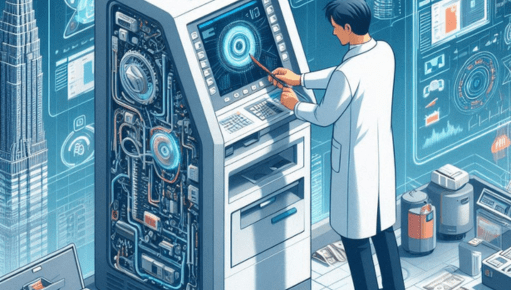In today’s digital economy, automated teller machines (ATMs) play a crucial role in enabling fast, reliable access to cash. With the demand for ATMs steadily rising, entrepreneurs are eyeing opportunities to invest in ATM franchises. However, before stepping into this venture, it’s essential to understand the factors that influence the atm franchise cost and the potential returns on investment (ROI) it offers.
What is an ATM Franchise?
An ATM franchise is a business model where an independent owner, rather than a bank, operates ATMs. Through partnerships with major banks, these ATM franchises offer services such as cash withdrawals, balance inquiries, and even mini-statements. As the ATM operator, you earn a fee every time a customer uses your machine, making it a viable passive income source.
Key Components of ATM Franchise Costs
The overall cost of setting up an ATM franchise includes several elements. Here’s a breakdown of the major expenses:
- ATM Machine Purchase or Lease Cost
- Purchase: If you choose to buy an ATM machine, the price can range from $2,000 to $8,000, depending on the brand, features, and technology.
- Lease: Leasing is a more budget-friendly alternative, with monthly rates typically between $50 and $150 per month. While leasing reduces the initial outlay, it can increase total long-term expenses.
- Installation and Maintenance Fees
Installation charges for an ATM machine vary based on location and accessibility. Typically, installation can cost between $500 and $1,500. Maintenance is another ongoing cost and ensures the ATM is functional and secure. Some providers offer maintenance packages, which may cost around $100 to $500 annually. - Cash Replenishment Fees
To keep the ATM operational, cash must be refilled regularly. You can handle cash replenishment yourself, but most franchisees hire a third-party service provider. Outsourcing cash management can range from $500 to $1,500 monthly, depending on the machine’s transaction volume. - Banking Network and Processing Fees
Most ATMs are connected to networks like Visa, Mastercard, or Cirrus, allowing customers from various banks to use them. The ATM operator pays network fees on each transaction, typically a few cents. Additionally, processing fees charged by banks or payment processors range from 0.5% to 1% of each transaction. - Site Rental or Revenue Sharing Agreements
If the ATM is placed in a high-traffic area such as a mall or shopping center, you may incur rental fees. Alternatively, some locations offer a revenue-sharing agreement, where a percentage of the ATM’s transaction revenue goes to the site owner.
Factors Influencing the Profitability of an ATM Franchise
Once you’ve covered the initial investment and operational expenses, the next step is to analyze factors that determine profitability:
- Location
Location is a crucial factor in the ATM business. ATMs placed in high-traffic areas, such as malls, gas stations, or shopping centers, are likely to have higher transaction volumes. Greater foot traffic equates to more transactions, which results in more revenue. - Transaction Volume
The number of transactions an ATM processes daily directly impacts revenue. On average, each transaction generates a service fee, which typically ranges from $1.50 to $3.00. An ATM processing 300 transactions monthly could generate $450 to $900 in monthly fees, depending on the charge per transaction. - Surrounding Demographics
The type of customers that frequent your ATM location can also affect profitability. ATMs in areas with limited access to banks, such as rural regions or areas with lower credit card penetration, tend to attract more users. People often prefer using ATMs in these areas rather than searching for bank branches, which can significantly boost your revenue. - Marketing and Brand Recognition
Working with well-established bank brands or ATM network providers can draw more customers. Additionally, some ATM companies offer mobile apps or websites that guide customers to nearby ATMs, increasing visibility and potential transactions.
How Much Can You Earn from an ATM Franchise?
Potential earnings from an ATM franchise largely depend on location, transaction fees, and volume. Generally, each transaction provides the ATM operator with a fee. For instance, if an ATM franchise owner charges a $2.50 service fee per transaction, and the ATM averages 300 transactions monthly, the potential revenue is around $750.
However, it’s essential to factor in expenses like cash replenishment and maintenance. After subtracting these costs, the monthly profit might vary, but a well-located ATM can earn an average of $200 to $400 in monthly profit.
Financing Options for ATM Franchise Cost
For entrepreneurs who may not have the upfront capital to cover the ATM franchise cost, there are financing options available:
- Bank Loans: Many banks offer small business loans for ATMs.
- Leasing Options: Some providers allow you to lease both the machine and related equipment, with an option to purchase at the end of the lease term.
- Partnerships with Banks or Networks: Some ATM companies offer partial financing for franchisees who agree to revenue-sharing terms.
These financing options can help you reduce upfront costs and gradually pay off the equipment investment over time.
The Advantages of Investing in an ATM Franchise
ATM franchises offer several benefits for investors, including:
- Low Time Commitment: Once the machine is installed and functioning, it requires minimal intervention.
- Passive Income Stream: ATM franchises can generate a consistent passive income from transaction fees.
- No Staff Requirement: Since ATMs are self-operating machines, they eliminate the need for employees or staffing costs.
- Scalability: Once successful, it’s easy to expand by installing more ATMs in other locations, multiplying revenue streams.
Potential Challenges in the ATM Franchise Business
While the ATM business model offers many advantages, it does come with its share of challenges:
- Technological Upgrades: Regular software and hardware upgrades may be required to keep the ATM secure and functional, incurring additional costs.
- Cash Flow Management: Cash replenishment is crucial; hitachi atm franchise cost poor cash flow can lead to machine downtime, resulting in lost revenue.
- Security Concerns: ATMs can be vulnerable to theft or vandalism, so insurance and security measures are essential.
- Regulatory Compliance: ATM operators must comply with local regulations, including security, data protection, and financial reporting.
Is an ATM Franchise Right for You?
An ATM franchise offers a unique business opportunity for investors looking to generate passive income. However, evaluating the ATM franchise cost alongside potential revenue, market conditions, and your financial capacity is essential to ensure a profitable venture. A well-located ATM with consistent transaction volumes can provide steady revenue, but success ultimately depends on how strategically you manage the business.
Investing in an ATM franchise can be highly rewarding with the right planning, research, and focus on customer needs. Make sure to evaluate the cost components, analyze the potential profits, and consider the long-term scalability before making your investment decision.




